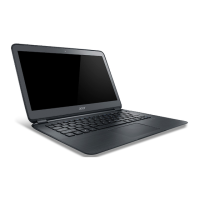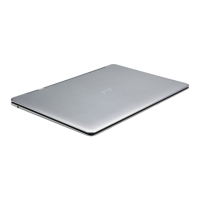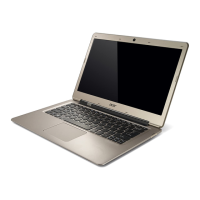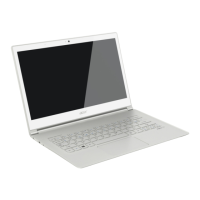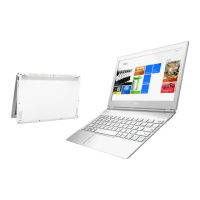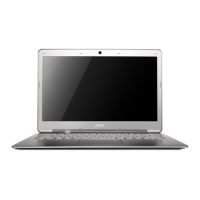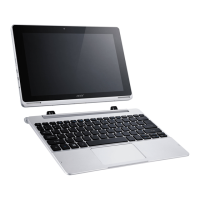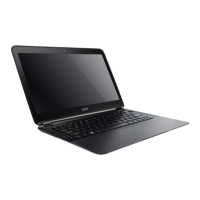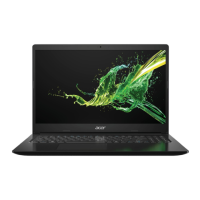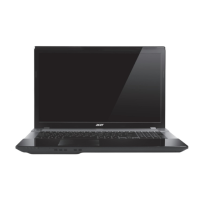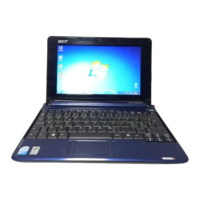Do you have a question about the Acer Aspire S3 and is the answer not in the manual?
Information on setup and quick guides for using the Acer notebook.
Guidelines for turning the computer on/off and general maintenance.
Instructions for powering the computer on, off, and putting it into sleep/hibernate.
Precautions for maintaining the computer's physical condition and preventing damage.
Proper handling and maintenance procedures for the AC adapter.
Steps for cleaning the computer and when to seek service.
Identification and description of screen components and features.
Identification and description of keyboard components and indicators.
Identification and description of ports and connectors on the left side.
Details about USB 3.0 compatibility and features.
Identification and description of ports and connectors on the right side.
Identification and description of components on the base of the notebook.
Explanation and usage of function keys (hotkeys) for various computer functions.
Description of the function of Windows-specific keys on the keyboard.
Introduction to touchpad operation and basic gestures.
Detailed explanation of various gestures for controlling applications.
Steps to create a backup of the system for recovery purposes.
Process for backing up drivers and applications.
Methods for restoring the system to a previous state or factory condition.
Procedure for reinstalling pre-installed software and drivers.
Using System Restore to revert the computer to a previous state.
Restoring the computer to its original factory state.
Factory reset using Windows options.
Restoring the system using a previously created recovery backup.
Instructions for connecting to the internet using a wired Ethernet connection.
Steps for connecting to a wireless LAN (Wi-Fi).
Guide to connecting to the internet using a cellular 3G network.
Steps to turn Bluetooth on and off on the computer.
Procedure for enabling Bluetooth within Windows 8.1 settings.
Process for pairing new Bluetooth devices with the computer.
Overview of icons and functions in the Acer Touch Tools control panel.
Explanation of the AccuFinger pointer and its usage for precise screen interaction.
Detailed guide on using AccuFinger for various touch operations.
Description of RepliView feature for virtual keyboard visibility.
Customizing Acer Touch Tools settings like pointer size and operation mode.
Introduction to Acer Screen Grasp tool and its toolbar functions.
How to modify default settings and enable gestures for Screen Grasp.
Features and tools available for editing captured screen images.
Using Acer Scrapboard to manage screen captures and organize images with tags.
Configuring the computer's boot order in the BIOS utility.
How to set passwords for system access within the BIOS utility.
Explanation of different password types and their security levels.
Process and prompts for entering passwords for BIOS and system access.
Tips and methods for conserving battery power and reducing energy consumption.
Steps to disable the fast startup feature to save power.
Information about the Lithium battery and its charging behavior.
Instructions for charging the computer's battery using the AC adapter.
Procedure for conditioning a new battery pack for optimal performance.
Tips for extending battery operational time and lifespan.
How to view the current battery charge status on the taskbar.
Actions to take when the battery charge is critically low.
Steps to safely disconnect the computer from external accessories.
Tips for moving the computer short distances.
Steps to prepare the computer for moving or travel.
Items to bring for meetings, considering meeting duration and battery status.
Guidelines for moving the computer between office and home.
Essential items to carry when traveling with the computer.
Important precautions for protecting the computer during travel.
Recommendations for setting up a comfortable and efficient home office.
General advice for traveling with the computer.
Specific considerations for international travel with the notebook.
Details on the proprietary port for extending computer connectivity options.
Overview of ports and jacks for connecting peripherals.
Information about memory cards and their usage with the computer.
Step-by-step guide for inserting memory cards into the reader.
Information on different types and capacities of SD cards.
Procedure for safely ejecting memory cards.
Steps for connecting an external monitor via VGA or DVI.
Using headphone and microphone ports for audio devices.
Explanation of the HDMI interface for digital audio/video connections.
Information on USB ports, standards (USB 2.0 vs 3.0), and device connections.
Troubleshooting steps for power and boot-up issues.
Diagnosing and resolving issues with a blank screen.
Troubleshooting steps for sound issues.
Steps to troubleshoot unresponsive keyboard issues.
Checking connections and power for printer functionality.
Information on restoring the computer to its factory settings.
Methods to access the Start screen in Windows 8.1.
Explanation of the Charms feature and its functions.
Configuring Windows 8.1 to boot directly to the desktop.
Instructions for shutting down the computer in Windows 8.1.
Procedure for unlocking the computer using a password or PIN.
Customizing the lock screen with images and apps.
Customizing the Start screen with background images and tiles.
Using the computer as an alarm clock.
Rearranging tiles on the Start screen.
Organizing tiles into named groups on the Start screen.
Resizing tiles on the Start screen.
Steps to close an application in Windows 8.1.
Finding and viewing all installed applications.
Explanation of Microsoft accounts and their use in Windows.
Pinning shortcuts to Start for Internet Explorer pages.
Procedure for checking and installing Windows updates.
General advice for diagnosing and resolving common system problems.
List of common error messages and their corrective actions.
Initial steps for protecting the computer before connecting to the internet.
Guide to selecting an ISP for internet connection.
Overview of different internet connection methods (Dial-up, DSL, Cable, 3G).
Information on setting up wired and wireless local area networks.
Introduction to using Internet Explorer for web browsing.
Overview of pre-installed McAfee Internet Security Suite features.
Definitions of terms like viruses, spyware, and malware.
Strategies for protecting the computer from online threats.
Guidelines for creating and managing secure passwords.
Advice on safely sharing personal information online.
| Graphics | Intel HD Graphics 3000 |
|---|---|
| Operating System | Windows 7 Home Premium |
| RAM | 4GB |
| Display | 13.3-inch (1366x768) |
| Battery Life | Up to 6 hours |
| Dimensions | 323 x 218.5 x 13.1 mm (12.72 x 8.60 x 0.52 inches) |
| Processor | Intel Core i5/i7 (depending on model) |
